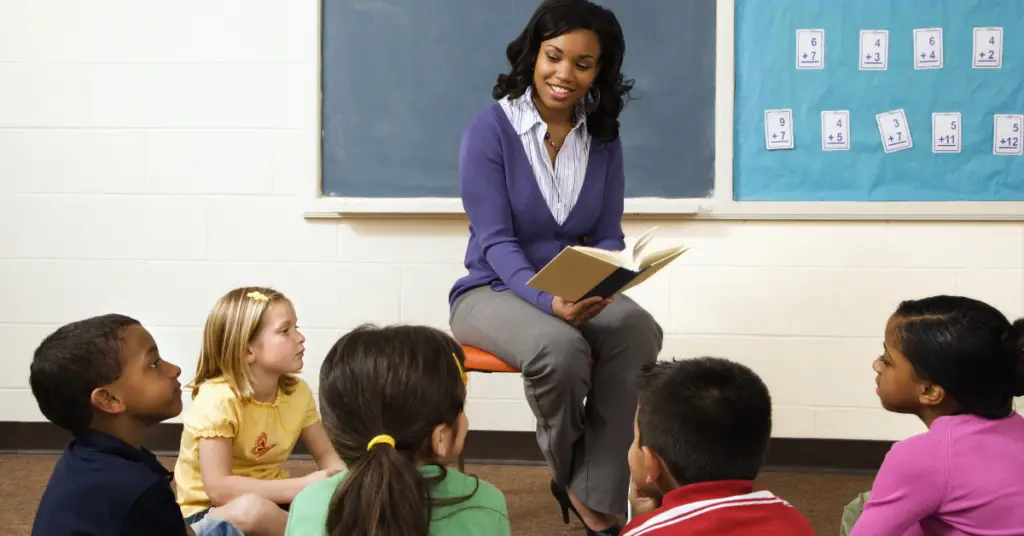Echo reading is a fluency-building strategy in which the teacher reads aloud a text line by line or sentence by sentence, modeling appropriate rate and prosody. After reading each line, the students echo back the reading of the line with the same rate and prosody.
Echo reading can be used with any type of text, including fiction and nonfiction, poetry and prose. It is an effective way to build fluency, phonemic awareness, and phonics skills. Echo reading can be used with individual students or small groups of students. It can also be adapted for use in whole-class instruction. When using echo reading with whole-class instruction, the teacher can read aloud a line or sentence from the text and then have the students repeat the reading. The teacher can also invite volunteers to read aloud a line or sentence and then have the class repeat the reading. Echo reading is a flexible strategy that can be used in a variety of ways to support student learning.
How echo reading can help improve your reading skills
Echo reading is a simple, yet effective, technique that can help improve your reading skills. The basic idea is to read a text aloud, then immediately echo back what you have just read. This helps to engage both your eyes and your ears in the process of reading, and can also slow down your reading speed, which can be helpful for understanding complex texts.
In addition, echo reading can also help to improve your pronunciation and increase your vocabularly. By repeatedly hearing words spoken aloud, you will be more likely to remember them, and using them correctly. Echo reading is a simple way to improve your reading skills, and it can be done anywhere, at any time. So why not give it a try? You may be surprised at the results.
The benefits of echo reading
Echo reading is a great way to improve your reading fluency and comprehension. When you echo read, you read a selection aloud, then read it again, simulating the way someone might read to you. This allows you to process the words and their meaning more deeply, improving your understanding of the text.
Echo reading also forces you to slow down and pay attention to the words on the page, which can help you catch errors that you might otherwise overlook.
In addition, echo reading can be a helpful tool for developing a clear and expressive reading voice. By reading aloud and listening to your own voice, you can learn to modulate your tone and pace in order to bring out the meaning of the text. Whether you’re looking to improve your reading skills or develop a more powerful reading voice, echo reading is a valuable tool.
The different ways to use echo reading
Echo reading is a technique that can be used to improve reading fluency. To echo read, the reader says the words of the text aloud while also reading them silently. This allows the reader to hear the words as they are read, which can help to improve fluency and pronunciation.
Echo reading can also be used to model fluency for struggling readers. By hearing a fluent reader echo read, they can see how the words should sound when read correctly.
Additionally, echo reading can be used as a comprehension strategy. As the reader says the words aloud, they can also think about their meaning and make connections to their prior knowledge. This can help to increase understanding of the text. Overall, echo reading is a versatile tool that can be used to support reading development in a variety of ways.
How to get started with echo reading
A key strategy for developing reading fluency and comprehension is echo reading. Echo reading involves reading a text aloud in unison with another person or recording. As you read, you echo or mirror the intonation, phrasing, and expression of the model reader. This allows you to internalize the rhythm and flow of the text, which can help you to read with greater fluency. In addition, echo reading can also help you to better understand the meaning of the text. By reading along with a model reader, you can gain insights into how to emphasize certain words or phrases in order to convey the author’s intended meaning.echo reading can be an effective way to improve your reading skills.
To get started, find a partner or recording that you feel comfortable reading with. Then, take turns reading passages aloud, making sure to match the intonation and phrasing of the other person. With practice, you will be able to read with greater fluency and understanding.
Tips for using echo reading effectively
Echo reading is a great way to improve your reading speed and accuracy. Here are four steps to get started:
1. Find a quiet place to read where you won’t be interrupted.
2. Set a timer for one minute.
3. Start reading aloud at your normal pace.
4. When the timer goes off, immediately start reading again, this time echo-reading the sentence you just read. Repeat this process for the entire minute.
5. After one minute, stop and take a break.
6. Repeat the process for five minutes, then 10 minutes, and so on until you’ve reached your desired echo-reading time.
FAQs about echo reading
Echo reading, also known as Reflective Reading, is a reading comprehension strategy in which students read a text twice. The first time they read it for gist, or the main idea. The second time they read it for details. This strategy helps students to better understand and remember what they have read. FAQs about Echo Reading:
1. Why is echo reading effective?
Echo reading is an effective comprehension strategy because it allows students to process the information at their own pace. Additionally, by reading the text twice, students are able to better comprehend and remember the information.
2. How can I use echo reading in my classroom?
Echo reading can be used with any type of text, including fiction and nonfiction texts. To use this strategy, simply have students read the text twice. The first time they should focus on understanding the main idea. The second time they should focus on understanding the details.
3. Are there any drawbacks to using this strategy?
While echo reading is generally an effective strategy, there are a few potential drawbacks to consider. These include the possibility of student frustration if they are not able to comprehend the text the second time around, and the need for extra time to complete the activity. However, these drawbacks are typically outweighed by the benefits of using this strategy.
4. How can I differentiate echo reading for my students?
There are a few ways to differentiate echo reading for your students. For example, you could provide different texts for students to read based on their reading level. Additionally, you could have students read the text more than twice if they need extra practice comprehending the information.
5. What other strategies can I use to support student comprehension?
In addition to echo reading, there are a number of other strategies that can be used to support student comprehension. These include:
-Answering questions about the text
-Retelling the story in sequence
– Summarizing the main ideas
– Identifying cause and effect relationships
– Comparing and contrasting characters, settings, or events
– Generating questions about the text
– Making predictions about what will happen next in the story.
No matter which strategy you use, the important thing is that you are supporting your students in their efforts to comprehend the text.
Conclusion
Not only does echo reading improve your ability to read, but it also helps with understanding and fluency. When you read aloud and then listen to yourself, you start to get a feel for the rhythm and flow of the words. You can use this skill when comprehending text as well. By changing up your pace and tone, you bring out different parts of the meaning in what you’re reading. So whether your goal is kicked-up reading skills or a more emphatic voice while doing so, give echo reading try – it just might be exactly what (and how) you need it.





